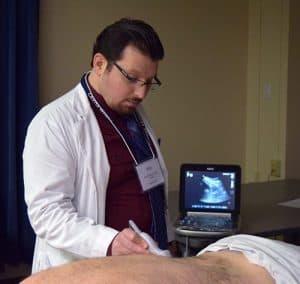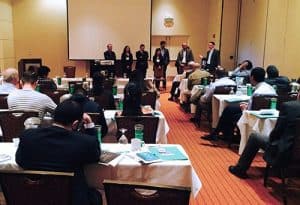Kidney Conference Focuses on Renal Biopsies
| April 22, 2016 | The first UAMS Kidney Con was a hands-on affair, with presenters and attendees alike heading back into a skills lab to practice performing ultrasounds of the kidneys and ultimately, ultrasound-guided renal biopsies.
Approximately 45 nephrologists, nephrology fellows, and internal medicine residents from Arkansas and the surrounding states attended the two-day conference April 8-9, which was sponsored by the UAMS College of Medicine’s Division of Nephrology and held in the Education II Building and the Doubletree Hotel in downtown Little Rock.
The goal of the conference was four-fold: provide a forum for communication among the region’s nephrologists; distribute clinical information to enhance prevention and treatment of kidney disease; conduct a renal biopsy demonstration with attendee participation; and promote research collaborations between nephrologists in the academic and private sectors.
As part of the conference, for which participants could get up to 13 hours of continuing education credit, attendees practiced ultrasound-guided renal biopsies. The hands-on training began with a demonstration and ultrasound workshop on standardized patients. Next up, attendees used simulation technology to practice biopsies before performing renal biopsies on human cadavers.
“We decided to teach proper renal biopsy techniques because 9 percent of all kidney samples collected during renal biopsies are inadequate for diagnosis, an error that requires patients to undergo additional, unnecessary procedures,” said John Arthur, M.D., Ph.D., director of the Division of Nephrology. “Giving nephrologists hands-on experiences at a conference is a good way to reinforce best practices for conducting essential renal biopsies.”
Akula Yougandhar, M.D., a nephrology fellow at the University of Mississippi Medical Center, praised the hands-on session, saying it “helped me to be at ease with kidney biopsies.”
“The format was well designed, with each piece building on the lessons of the previous one,” he said. “While all of it was informative, the highlight of the session was performing biopsies on cadavers.”
Trinh Nguyen, M.D., an internal medicine resident at the University of Texas Medical Branch said, “I am so grateful for the dedicated hands-on teaching time to learn and perfect an ultrasound guided renal biopsy procedure I would not have otherwise learned in residency.”
“Kidney Con broadened my outlook of nephrology, as I have learned different aspects of the field and how it relates to everything from interventional radiology to critical care.”
Javier Neyra Lozano, M.D., a nephrology fellow at the University of Texas Southwestern Medical Center called the conference “a great balance of a hands-on precourse experience and dynamic lectures and discussions.”
“I think the organizing committee did a superb job assembling this meeting, which is a great platform to acquire new knowledge, generate relevant research questions, and develop collaborative high-quality research,” he said.
On Saturday, the conference focused on the treatment of acute kidney injury, chronic kidney disease, lupus nephritis and glomerular disease. Presenters utilized audience response technology and presented case studies, as well as participated in panel-style Q and A sessions.
Sixteen physicians from UAMS, the Medical University of South Carolina, Emory University in Georgia, the University of Tennessee at Chattanooga, the University of Mississippi, the University of Alabama at Birmingham, the University of Illinois at Chicago, Ohio State University and Nephropath, a private pathology lab, taught sessions at the conference.



